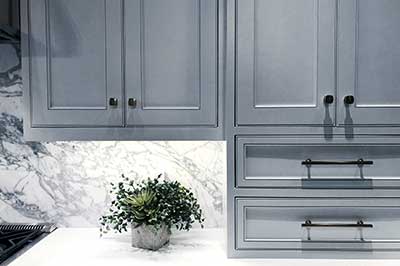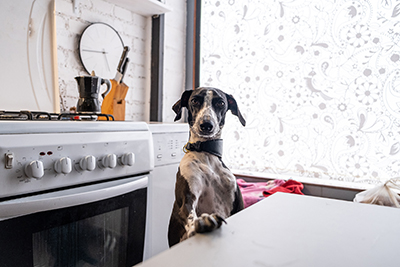Buying Kitchen Cabinets
Last updated May 2022
Are you ready for a kitchen makeover? Here's advice on how to get the kitchen you crave for the least amount of hassle and money. We provide tips and ratings to help you plan your space, find the right designers, suppliers, and contractors, and get good prices.
Design Decisions
 Start by considering basic questions:
Start by considering basic questions:
- What do you like about your current kitchen? What do you hate?
- How do you plan to use the kitchen—a center of family activities; a place to eat most or all meals; for gourmet-level cooking, sometimes with more than one chef; for entertaining guests; a makeshift space for conducting family business?
- Do you want to make structural changes? Replace appliances?
- How much are you willing to spend?
- Do you have a certain look or finishes in mind? Whether you buy materials yourself or buy through a designer or contractor, collecting a portfolio of kitchens you like can help you organize your vision. Pinterest is a great resource for ideas, as are home design magazines and websites.
There are compelling reasons to get professional design help: Pros usually know how to make kitchens look better and function more efficiently, and they can figure out ways to help keep down project costs. With their expertise, you can avoid mishaps—like discovering you can’t install a fixture because a pipe blocks the way. And if suppliers or installers get something wrong, a professional designer has more leverage to push for making it right.
A professional might be a kitchen designer or architect who only creates designs—for a fee. More commonly, consumers get design services from businesses that sell cabinets and other kitchen supplies. Some of these companies charge hundreds, or even thousands, of dollars for design services. Others waive the fee if you end up buying cabinets or other items through them. And some companies provide the design for free—as a cost of marketing—and only hope that you wind up purchasing through them.
Arrange to interview several designers. Here at Checkbook.org you'll find customer reviews of contractors and remodelers (which include many kitchen specialists), cabinet retailers, and countertop suppliers.
When meeting with designers, assess their taste and how easy it is to communicate with them. We prefer designers who will visit your home, not just recommend products at the store based on room measurements. A meeting in your existing kitchen is likely to cook up the most creative ideas. Also, your measurements might miss something: One designer told us of a client who measured the space between windows—correctly recording from the outside of one window’s trim to the outside of the next window’s trim, but failing to notice that the trim on one side of a window had already been cut down. Based on those measurements, the cabinets would not have been properly centered.
When you find a promising candidate, ask to see a portfolio of previous work and for a list of references. Also discuss timing; how many draft plans the designer will provide; whether you have to use the designer’s own contractors; how closely the designer will supervise the installation; whether you will have to buy cabinets, countertops, fixtures, appliances, and other items through the designer; and how the designer will be compensated.
We recommend arrangements that let you compare prices and buy from a supplier other than the designer, if the price is right. For this freedom, it’s worth paying a design fee. Markups on cabinets, countertops, and other items can be substantial; don’t get stuck with a designer who provides a free design and more than makes up for it with excessive markups. Click here for our advice on getting the best deal on appliances.
Companies that don’t charge design fees and don’t require you to buy through them are particularly attractive options. This lets you shop for competitive prices to make sure you don’t overpay for cabinets and other items. Of course, in the end you might be willing to shell out extra to buy through the company that provides the design, either because it seems fair or because you are pleased with the plan and want to keep the designer involved throughout the project.
Shopping for Cabinets (and Avoiding High Prices)
You will have to decide on the number, types, and sizes of cabinets; type of wood; door style; finish; knobs; and features and accessories. The websites of major manufacturers such as Wood-Mode; Fieldstone Cabinetry; KraftMaid; and Zonavita display types, styles, and finishes; provide assistance with creating plans; and answer many of your questions. These are excellent resources; visit them before you contact designers.
Start by checking the customer reviews of cabinet suppliers we have collected. Then visit stores, keeping in mind:
- Stock cabinets, which are mass-produced in standard sizes, generally cost less than custom or semi-custom cabinets. Custom cabinets made to order to fit your exact size needs usually consist of the best materials. Semi-custom units are also made to order, but in standard sizes that may require spacer-inserts to fit your space exactly.
- Wood grain that matches from piece to piece and furniture-quality finish are signs of quality.
- Look for drawers with dovetailed joints, drawer sides of 1/2-inch or 3/4-inch plywood, and drawer bottoms fitted and glued into side grooves. High-quality drawers should pull out completely. Doors with fitted mortised corners are sturdier than those made with non-interlocking butt joints. Top-quality cabinets usually have solid-wood face frames at least 3/4 inches thick. For the cabinet box, avoid thin sides, backs, and floors; especially avoid thin particleboard.
- Ask how long it will take for suppliers to deliver various options. There will always be a wait, but as of this writing supply-chain-problem shortages and shipping snafus meant many suppliers couldn’t deliver for four to six months, and some warned of even longer turnaround times.
 Once you have decided on a plan and on type and style of cabinets, make a detailed list of each part of your order, specifying manufacturer, style, wood type, finish, size, and features. Then contact several suppliers and ask for prices.
Once you have decided on a plan and on type and style of cabinets, make a detailed list of each part of your order, specifying manufacturer, style, wood type, finish, size, and features. Then contact several suppliers and ask for prices.
The table below shows the range of prices Checkbook’s undercover shoppers were quoted when they provided local cabinet sellers specifications for 13 KraftMaid cabinets (plus filler overlays, toe kicks, and molding) for an average-size kitchen remodel.
Unfortunately, because different vendors generally sell different makes, you won’t be able to compare prices for the same exact cabinets at dozens of sellers. But most major brands will have several dealers within reach. Find them by visiting the manufacturer’s website.
You’ll also find that some stores, including Home Depot and Lowe’s, offer cabinets identified by style names not available elsewhere. For example, we sought pricing from area cabinet suppliers for KraftMaid’s “Fox Chase” line, but Home Depot doesn’t sell it; instead, it offers a KraftMaid style it calls “Fox Hill.” Similarly, Lowe’s sells a KraftMaid line it calls “Fox Ridge.” Some other stores offered us Merillat “Fox Court” cabinets (Merillat is now owned by KraftMaid). And still other suppliers offered “Fox” styles from both KraftMaid and Merillat. Based on the specifications lists we reviewed, as far as we could tell all four of these styles referred to the same cabinets—or at least comparable ones. You might have to do your own sleuthing to crack the codes for similar private labeling schemes.
Here’s what our shoppers found:
- There was substantial dealer-to-dealer price variation. We were quoted prices ranging from $7,982 to $15,945—a difference of nearly $8,000.
- Home Depot and Lowe’s did not offer the lowest prices.
- Although we provided dealers with a list of specific cabinets, a number offered to come to our home to confirm our measurements at no additional cost.
If the price of new cabinets busts your budget, consider painting or re-facing existing cabinets. This is a good option if your cabinets are well-constructed and in good condition beneath the surface, and you are satisfied with the existing kitchen layout and design.
The best thing about painting is the price. The materials to paint cabinets should run about $200, while replacing similar cabinets would cost $8,000 or more. Even hiring a painter to do the work can cost less than $2,500.
Although re-facing is much more expensive than painting, it should still cost only about 70 percent as much as replacements. A professional re-facer usually replaces cabinet doors and drawer fronts, and covers exposed face frames of the cabinets with a wood or plastic veneer that matches the new doors.
Working with Your Suppliers or Contractor
Lots of homeowners who buy new kitchens don’t have fond memories of the experience (to put it mildly). But there are many ways to ensure smooth redos, starting with insisting on a solid contract. Click here for lots of advice on how to supervise and survive remodeling projects.


